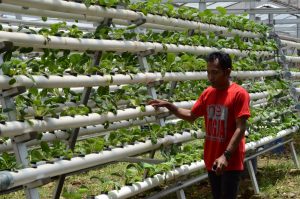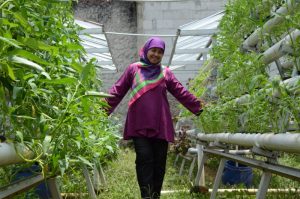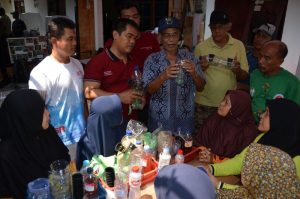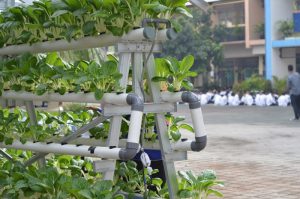For engineer Syahruddin and wife Tri Mulyani, farming started out as a hobby. But with peer support and an increasing demand for healthier lifestyle and produce, their Omega hydroponic farm is helping their community to become more aware of and resilient to environmental degradation and climate change. Read their story.
By Helena E. Rea
South Tangerang, Banten. Syahruddin dived into one of the world’s deepest oceans to provide data and evaluation before installing oil pile or communication cables for an offshore oil and gas company in East Kalimantan for 25 years. That was before a slowdown in oil industry in 2010, which prompted him to leave his dangerous job and returned to Bandung, East Java with his wife and three children.
Working as a freelancer with much time in his hands, Syahruddin decided to use up his free time to start his hobby, gardening. A hobby that has turned the geophysicist to a hydroponic farmer.
“At first, gardening is just [my] hobby. I didn’t really understand [what] hydroponic gardening [is],” said the man who graduated Meteorology, Oceanography, and Geophysics of Bandung Institute of Technology (ITB) in 1978, to Ekuatorial.com, recently.
However, Syahruddin and his wife, Tri Mulyani, decided to take hydroponic gardening seriously as they received support and investment, from their college friends who had established a cooperative union, Koperasi Jasa Omega Ganesha Mandiri, in 2015.
The Cooperative, comprises of 100 members also alumni of Meteorology, Oceanography, and Geophysics of ITB, was formed out of good will to do pro-bono work for the less fortunate.
Unfortunately, some of their ideas, including chicken farming and banana plantation were not feasible due to lack of capital and land availability.
“There were lots of ideas [but] all got stuck with the funding issue for the needs of large capital,” said Mulyani, who graduated from the same major of her husband, adding that at least 25 out of 100 members have finally agreed to invest on hydroponic garden as it was less capital and land.
One of the members, Irian Sitorus, also founder of Sekolah Tinggi Ilmu Ekonomi Paripurna (STIE Paripurna), lend a total of 621 square meter of land located in Graha Bintaro, South Tangerang, for the garden.
With limited land, Syahruddin constructed 31 compartments with A-shape. One compartment is an installation block with the shape of letter A which consists of six levels of pipes to each of the sides.
Each of those pipes have 36 growing chambers making it a total of 432 growing chambers. These hundreds of compartments were, then, positioned to be exposed with enough sunlight.

On September 2016, Omega Hydroponic Garden, derived from Oceanography, Meteorology and Geophysics, their major in college, was ready to be planted.
“We started to plant vegetables. I was doing all the research as I have more time,” said Syahruddin, who previously spent six months in a vessel to locate oil drilling spots.
They planted kale, lettuce, pak choi, choy sum (caisim), Chinese cabbage, spinach, and water spinach. Then, they moved the vegetables to rockwool or growing medium.
These vegetables have planting period that vary. For instance, water spinach needs 15 to 21 days, kale needs 35 days, broccoli would take up to two months before harvest, meanwhile, pak choi, choy sum, Napa cabbage, and lettuce need at least 30 days before harvest.
After harvesting, these vegetables will be washed and ozonized before packaging and sold to customers.
However, it was not a smooth sail as Syahruddin experienced failed crops in the early days. “I was really worried,” he said questioning the failed crop using mathematics.
If the answer was mathematics, he said, then there was something wrong in the planting process as ideally, all plants should have grown. Syahruddin got his answer from his friend working at the Ministry of Agriculture who advised him that farming could not be measured through mathematics.
“For instance, if we plant trees, a few failed, a few grow perfectly, that’s the concept of farming,” he recalled. “However, discipline and persistence are the main key. These need to be maintained day by day,” he said.
Becoming a farmer, he said, gave Syahruddin a different perspective compared to when he was working as a geophysicist who often dealt with matters of life and death. In gardening, he had found a different side of life as he watched seeds grow, he sees greatness of God.
“Mashallah [God has willed] from a small seed can turn into bigger vegetables,” he said.
Meanwhile, Mulyani, his wife, points out one of the challenges in becoming a farmer; maintaining the sustainability of the garden.
“Our culture is not [as real] farmers so it doesn’t bind us [to work in the garden]. However, [developing] hydroponic garden does require control every day from us,” she said.
Ensure Sustainability and Greater Good for Peoples
As it started out as hobby, the self-made hydroponic farmers have yet to reap profit from their new endeavor.
For Omega Hydroponic Garden, sales revenue reaches 18 million rupiah per month from 3000 packages with the price of Rp6,000 per package, harvested from 25 compartments. However, the operational cost for 25 compartments range between 12 to 15 million rupiah.
“It is naive to think to be able to get rich from hydroponic garden,” said Mulyani adding that there was still no visible market for these vegetables in the urban cities.
“Our market is friends or neighbors,” she added.

Furthermore, she said that hydroponic products face sturdy competition in the market, due to its high price. Nevertheless, Mulyani believes with time and patience, profit is abound as demand for alternative, healthier produce is increasing.
Hence, business model being developed is one garden for one housing area, to be able to create consumers in the area.
“There are lots of end users. There are individuals, or people with social activities who buy vegetables from us to be donated to their communities, “she said targeting break-even point (BEP) in 2019. “Our friends from the Cooperative have also bought vegetables from Omega Hydroponic Garden and distributed them to orphanages.”
Early Education on Hydroponic Farming
Mulyani did not stop at just developing a hydroponic farm. She looked into the education aspect to spread the farming model.
Since 2017, she had received 16 groups or a total of 300 people, comprising of school children, doctors, and other communities, willing to learn about hydroponic garden.
At least 60 percent of the groups that received the training were able to develop their own hydroponic garden.

For school children, she added, they came to study as part of the curriculum or extra-curriculum set by the school.
“Teaching kids requires a lot of patience, so they would understand the process of planting and its benefit,” she said.
She recalled school children were enthusiastic in learning patterns and planting techniques as they were raised in urban cities, with very little awareness about natural phenomenon and its connection to environmental degradation and climate change.
“They only understand that the weather is getting hot. Climate phenomenon which they are learning in schools, rainy and dry seasons’ patterns seemed like an anomaly to them,” said Usep, one of the teacher of Baiturrahman Islamic Boarding School in Bandung, West Java.
“What I learn from planting is that [the plants] need sun and water so that vegetables can grow,” said Siti, 13 years old in the 8th Grade, who participated in the training with her friends.
“The most fun part in this is to be able to learn types of vegetables,” said Fauzi Robi Gunadi, another 8th grader. “We learn that we can utilize scraps for hydroponic farming although getting vitamins for these vegetables will be challenging.”

Mulyani said that there are several more schools or organizations that they are targeting to introduce the hydroponic garden to. In addition, together with her husband and the support of the cooperative, they are willing to assist in developing hydroponic garden in resident’s houses and encourage a healthier lifestyle.
Hydroponic Garden and Food Independence
Widiyanto, Manager of Rights to Food, Oxfam Indonesia, said that hydroponic farming was an initiative made by urban dwellers to tackle two issues, limited lands and reducing global warming.
Furthermore, Widiyanto underlined that hydroponic farming could become the solution for food independence of urban cities. Instead of waiting for food supplies from rural areas, residents could produce their own food and vegetables.
“Communities can become local market and serves as a crutch to healthy lifestyle,” he said. “With local food availability, we are no longer dependent on producers outside of our own neighborhood.”
Omega Hydroponic Garden had been replicated in Ciledug, Cipayung for Jakarta area and Punclut and Dago for Bandung area. Ekuatorial.
Helena E. Rea is a Jakarta based journalist.


